![]()
![]()
![]()
Use LEFT and RIGHT arrow keys to navigate between flashcards;
Use UP and DOWN arrow keys to flip the card;
H to show hint;
A reads text to speech;
187 Cards in this Set
- Front
- Back
|
Local effects of lung tumors
|
Airway obstruction --> pneumonia, abscess, lobar collapse
Hoarseness due to laryngeal nerve invasion Dysphagia Pleural effusion Nerve entrapment syndromes (e.g. Horner's due to Pancoast's tumors in apex) SVC syndrome |
|
|
Histoplasmosis with granulomatous inflammation
Acute phase: Small (2-5 uM) ovoid budding yeast forms seen in macrophages |
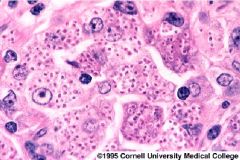
Identify the disease process and organism.
|
|
|
Candida. Pseudohyphae.
|
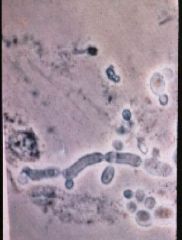
What organism is this?
|
|
|
What are the 4 characteristics of asthma?
|
a) Airway obstruction that is reversible either spontaneously or with treatment
b) Airway inflammation c) Increased airway responsiveness d) Airway remodeling |
|
|
Pleural effusion on R.
|
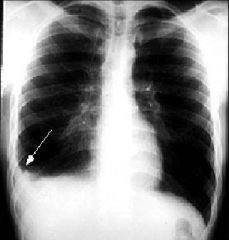
What's going on?
|
|
|
Define pneumonia
|
Inflammation of the lower respiratory tractm involving the alveolar space.
|
|
|
Definition of asthma
|
Airway obstruction that is reversible either spontaneously or with treatment (may not be complete)
Airway inflammation Increased airway responsiveness Airway remodeling |
|
|
Paraneoplastic syndromes
(specifically for small cell, squamous, carcinoid) |
Lambert-Eaton syndrome (antibodies to neuronal calcium channels)
Small cell: Hyponatremia due to ADH production, Cushing's due to ACTH Squamous: hypercalcemia due to PTH production Carcinoid: serotonin Adeno: DIC |
|
|
Histoplasmosis:
clinical presentation |
Granulomatous disease, interstitial disease, disseminated infection
|
|
|
What are the symptoms of Plummer-Vinson/Patterson-Kelly syndrome?
|
Anemia, glossitis, esophageal dysphagia
Very rare. |
|
|
What cytokines are induced by the Th2 response in asthma?
What are the consequences? |
IL-4, IL-13, Granulocyte-macrophage colony stimulating factor (GM-CSF)
B cells induced to synthesize IgE Eosinophils recruited |
|
|
Pulmonary causes of restriction (alveolar and interstitial)
|
Alveolar: filling (exudate, CHF), atelectasis/collapse (inadequate surfactant), airway obstruction
Interstitium: increased fluid (CHF), increased cellularity (leukocytes, (myo)fibroblasts), interstitial fibrosis |
|
|
What is Kartagener's syndrome?
|
(a.k.a. ciliary dyskinesia)
Cilia do not beat, affecting respiratory epithelium and all other parts of body with cilia. Predisposition to bacterial colonization and development of serious complications. |
|
|
Definition of chronic bronchitis
|
Excessive mucus secretion in bronchial tree
Chronic or recurrent productive cough Symptoms present most days for minimum of 3 months in year and not less than 2 successive years |
|
|
Squamous cell carcinoma:
common location |
Bronchial mucosa
|
|
|
Histoplasmosis:
Pathology |
Granuloma or sheets of histiocytes containing fungus
Resembles leishmaniosis (a protozoan) |
|
|
Irritation fibroma.
nodular mass of fibrous tissue occurring in the buccal mucosa along the bite line. |
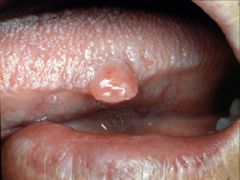
What is this?
|
|
|
What inflammatory cells are increased in asthma?
|
Mast cells, eosinophils, neutrophils (which release bronchospastic mediators like histamine and leukotriene, platelet activating factor)
|
|
|
Diffuse Interstitial Lung Disease
|

What is this?
|
|
|
What is the main inflammatory cell involved in bacterial pneumonia?
|
Neutrophil, filling bronchi, bronchioles, and alveolar space (only alveoli necessary to diagnose as pneumonia)
|
|
|
Definition of emphysema
|
Abnormal enlargement of airspaces distal to terminal nonrespiratory bronchiole, accompanied by destructive changes of alveolar wall.
|
|
|
Lobar pneumonia.
Edema, neutrophils |
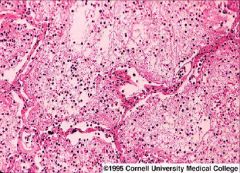
What's this?
|
|
|
Adenocarcinoma:
Location |
Usually peripheral, subpleural nodules
|
|
|
Coccidiomycosis
Spherule with large (5-100 uM) endospores inside When spherule ruptures, you get disseminated infection. |
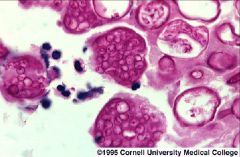
Identify disease process and organism
|
|
|
Irritation fibroma.
Squamous mucosa, fibrosis. Inflammatory cells sprinkled around stroma. |
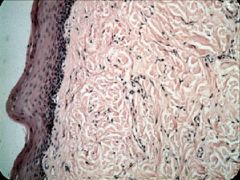
What is this?
|
|
|
UIP
Honeycombing, dilated spaces, surrounded by dense fibrosis. Some normal alveoli. |
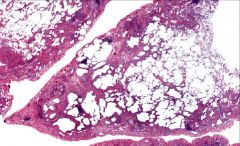
What disease?
|
|
|
What is the inflammation like in chronic bronchitis? (cell types)
|
Neutrophils in epithelium, mucous glands, and airways.
Eosinophils Depressed ratio of helper/suppressor T cells Subepithelial mononuclear cell infiltration of bronchial mucosa (macrophage CD8+ t cells) |
|
|
3 types of anti-inflammatory agents
|
Corticosteroids
Cromolyn sodium, nedocromil sodium Leukotriene modifiers |
|
|
What characterizes emphysema?
|
Abnormal enlargement of airspaces distal to terminal non-respiratory bronchiole, accompanied by destructive changes of the alveolar wall
|
|
|
Lobar pneumonia, red hepatization stage.
Alveolar spaces filled with blood. Neutrohils present, RBCs dominate. |

What disease? What stage?
|
|
|
Corticosteroids:
Mode of action |
Bind to cytoplasmic glucocorticoid receptor, which alloows translocation into nucleus, where it modifies transcription of numerous genes involved in asthma
Down-regulates: cytokines (IL-4, IL-5, GM-CSF), chemokines (Rantes, IL-8) Up-regulates: β-agonist receptor Decreases airway edema, increases response to beta-agonists. |
|
|
Coccidiomycosis:
Geography |
Southwestern US
|
|
|
Bronchioalveolar Carcinoma (BAC):
Location Characteristics Cellular composition Prognosis |
Peripheral, in terminal bronchiolar cells or alveolar walls
Abundant mucus production Well differentiated columnar cells containing mucin or cuboidal cells resembing Type II pneumocytes or Clara cells lining preserved septa Better prognosis than regular adenos when they are solitary and < 2 cm |
|
|
Pyogenic granuloma
highly vascular, pedunculated gingival lesion resembling an hemangioma. Occurs in children and pregnant women (“pregnancy tumor”). Vessels with lobulated appearance. Edema, inflammation, vascular proliferation*. |
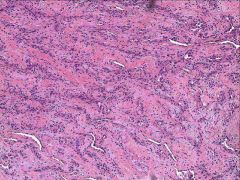
What is this?
|
|
|
UIP. Fibroblast foci
|
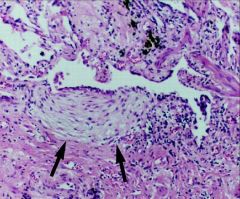
What disease?
|
|
|
Pathological findings of UIP/IPF
|
Patchy, nonuniform, variable interstitial changes, normal lung, active fibrosis and end-stage fibrosis (honeycomb lung).
Fibroblast foci Mild inflammation |
|
|
Lobar pneumonia. Gray hepatization stage.
Accumulation of neutrophils, disintegrating RBCs and fibrin. |

What disease? What stage?
|
|
|
What is the inflammation like in emphysema? (cells)
|
bronchiolitis w/plump, pigmented, activated alveolar macrophages in respiratory bronchioles
|
|
|
What is Wegener's granulomatosis?
|
Necrotizing vasculitis, with granulomas, areas of necrosis, collections of histiocytes, abundant chronic inflammation
|
|
|
Name corticosteroids:
Inhaled Oral IV |
Inhaled: beclomethasone
Oral: prednisone, prednisolone IV: methylprednisolone |
|
|
Histoplasmosis:
Geography |
Midwestern US (Ohio and Mississippi River valleys)
|
|
|
Types of neuroendocrine tumors in the lung
|
Benign tumorlets, carcinoids, atypical carcinoids, small cell carcinomas (increasing malignant potential)
|
|
|
UIP/IPF:
Clinical characteristics (age, onset, symptoms, prognosis, therapy) |
Most common IIP
Age: 50's, 60's Onset: insidious Symptoms: cough, dyspnea Prognosis: poor Therapy: none (except transplant) |
|
|
What is the predominant inflammatory cell type in legionella pneumonia?
|
Macrophage, full of bacilli and nuclear dust.
|
|
|
Nasopharyngeal angiofibroma
Benign, rare. Admixture of mature vascular and fibrous tissue. Some normal squamous epithelium with bland fibrous stroma witih myxoid areas and prominent vessels. Occurs almost only in males in teens. |
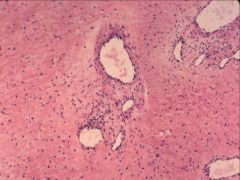
What neoplasm is this? What are its characteristics?
|
|
|
Asthma. the brown cells (bilobed) are eosinophils.
|
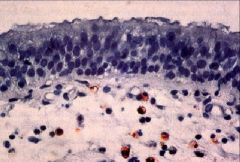
What inflammatory process is this?
|
|
|
Coccidiomycosis:
Clinical presentation |
Necrotizing granuloma
Disseminated disease is rare |
|
|
Corticosteroids:
Side effect |
(All depend on dose, delivery, and duration)
Musc: myopathy, osteoporosis GI: peptic ulcer CNS: psychiatric Ophal: post subcapsular cataracts CV/renal: hypertension Met: central obesity Endo: growth failure, suppression of HPA system, exacerbation of hyperglycemia Inhibition of fibroplasia (wound healing) Impaired immune response |
|
|
Bronchial carcinoid:
Location Microscopic appearance Malignancy and mortality |
Main stem bronchi or peripheral
Ribbons of polygonal cells separated by vascular spaces, silver stains show argyrophilic granules 5% have lymph node metastasis, but 5-10 year survival is 50-95% |
|
|
What is atypical about atypical carcinoid tumors in the lung?
|
More cytologic atypia, focal necrosis, mitoses
|
|
|
Desquamative Interstitial Pneumonia (DIP)
Increased macrophages in alveoli. Uniform appearance at low power. Moderate alveolar septal thickening due to collagen deposition. If it were in respiratory bronchioles, it would be RB-Interstitial Lung Disease (RB-ILD) |

What disease?
|
|
|
What is the antibiotic of choice for Legionellosis?
|
Erythromycin.
|
|
|
Sinonasal papilloma, fungiform/transitional cell type
Note the transitional epithelium |
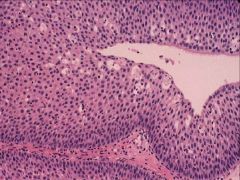
What neoplasm is this?
|
|
|
Asthma
|
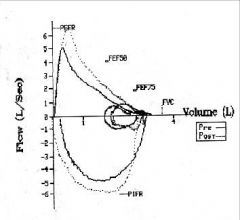
What disease does this spirogram represent?
|
|
|
Blastomycosis:
Geography |
Midwestern US (Mississippi and Ohio River Valleys)
|
|
|
Indications for inhaled corticosteroid
|
Controller/preventer
First-line anti-inflammatory in any pt with PERSISTENT asthma (requiring β-ag twice weekly) Use in COPD is controversial |
|
|
Desquamative Interstitial Pneumonia
Macrophages in alveolar space. Moderately thickened alveolar septae. |
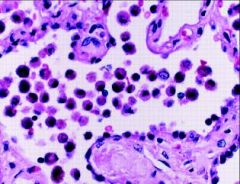
What disease?
|
|
|
Legionella.
Looks like necrosis. Mononuclear cells look dirty (nuclear dust). If stained with warthrin-starry, you'd see bacilli. |
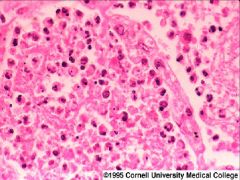
What pneumonia?
|
|
|
Sinonasal papilloma, inverted type.
See epithelial layer "growing in" High rates of recurrence |
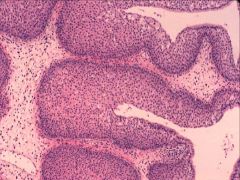
What is this?
|
|
|
What are the effects of cigarette smoke?
|
Increased mucus secretion, alveolar wall thickening, smooth muscle contraction
Damages nerve endings --> substance P --> mucus Recruits inflammatory cells Destroys cilia to move mucus out |
|
|
Small cell carcinoma:
Gross appearance Microscopic appearance |
bulky, white masses with necrotic areas
sheets and nests of small, hyperchromatic, round, oval, polygonal, or spindle cells with nuclear molding, crush artifact, DNA encrustation of BVs |
|
|
Blastomycosis:
Clinical presentation |
Similar to tuberculosis: pulmonary nodules and/or cavity
|
|
|
Indications for oral corticosteroids
|
Rescue therapy for acute exacerbation in out-patient asthma
|
|
|
DIP/RB-ILD:
Clinical characteristics (Age, onset, symptoms, associations, prognosis, treatment) |
40s
Insidious Cough/dyspnea, clubbing in 50% Smoking 30% mortality (RB-ILD not fatal) 60% respond to steroids, some improve spontaneously |
|
|
What differentiates pseudomonas aeruginosa pneumonia?
|
Vascular haze, vasculitis with hemorrhage and pumonary infarcts. (bacteria need lots of O2, so it localizes near BVs --> hemorrhage and infarct)
|
|
|
Olfactory neuroblastoma.
|
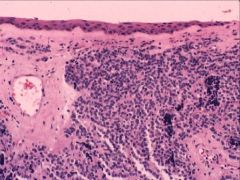
What is this, if it also is immunopositive for S-100, neutron specific enolase, and chromogranin?
|
|
|
What are PFT findings of chronic bronchitis?
|
Decreased expiratory flow
Decreased FEV1 Normal FVC (lung volumes are normal) |
|
|
Epithelial lung cancer types
|
Nonsmall cell types: Squamous cell carcinoma 25-40%, adenocarcinoma (including BAC) 25-40%, large cell carcinoma 10-15%
Prognosis better (resection possible) Small cell carcinoma (20-25%) Worse prognosis (chemo and radiation only) |
|
|
Blastomycosis
Broad area of contact between dividing yeast Large yeast form |
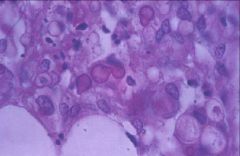
Identify disease process and organism
|
|
|
Indications for IV corticosteroids in asthma
|
Acute exacerbation in hospital
|
|
|
Pseudomonas aeruginosa. Vascular haze and hemorrhage.
|
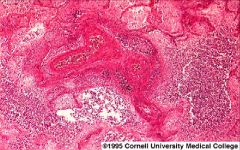
What pneumonia is this?
|
|
|
Acute Interstitial Pneumonia (AIP) or Hamman-Rich Disease
Diffuse alveolar damage, epithelial cell death, hyaline membranes, thombi, diffuse, active fibrosis with proliferating fibroblasts and myofibroblasts. Temporarily uniform appearance, but rapid evolvement of honeycomb lung. Looks like ARDS. |
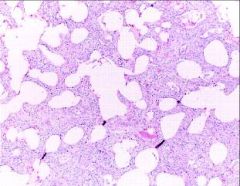
What disease?
|
|
|
Squamous cell carcinoma (could be nasopharyngeal carcinoma)
|
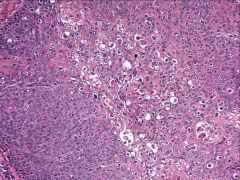
What neoplasm is this?
|
|
|
How does asthma differ from CB?
|
Type of inflammatory cell: TH2 and eos in asthma, macrophages, neutrophils, and CD8 T cells in CB
Location of inflammatory cells How those cells lead to obstruction |
|
|
Squamous cell carcinoma - making pearls
|
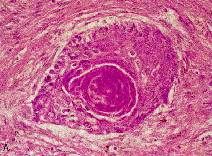
What is this?
|
|
|
Pneumocystis carinii pneumonia (PCP):
Clinical presentation |
-Insidious, slow progressive atypical pneumonia.
-Fast progressive pneumonia. -Typically presents as bilateral shadowing on a chest x-ray. -Respiratory failure is the most common cause of death. PCP can cause diffuse alveolar damage. |
|
|
Cromolyn sodium, nedocromil sodium:
Mechanism of action |
Stabilizes mast cell membranes, interferes with signal transduction in mast cells
|
|
|
What organism is most associated with bacterial pulmonary abscess?
|
Staph aureus.
|
|
|
Acute interstitial pneumonia (Hamman-Rich)
Diffuse fibrosis |
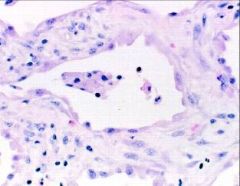
What disease?
|
|
|
What are the physical exam findings of emphysema?
|
Thin, pursed lips, decreased breath sounds, hyper-resonance, distant, faint heart sounds
|
|
|
What is the prognosis of nasopharyngeal carcinoma?
|
Poor. Grows slowly and unnoticed until unresectable size. Often spreads to lymph nodes and distally.
|
|
|
Adenocarcinoma - glandular
|
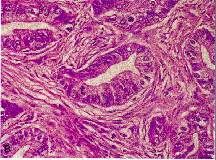
What is this?
|
|
|
PCP pneumonia:
Pathologic changes |
Intraalveolar, pink, foamy, honeycomb exudate that contains the cysts and trophozoites of P. carinii.
Atypical presentations: granuloma, bullous pneumotorax, DAD, interstitial fibrosis. |
|
|
Indications for neocromolyn sodium
|
Can be offered as first-line anti-inflammatory therapy, often in peds
Not as effective as CS, not effective in some pts at all. No side effects. |
|
|
Acute Interstitial Pneumonia (Hamman-Rich Disease):
Clinical presentation (Common? onset, symptoms, associations, mortality, therapy) |
Rare
Acute onset Dyspnea, resp failure (like ARDS) Viral prodome in most 60% mortality Supportive therapy |
|
|
Small cell carcinoma
Small, dark, like lymphocytes, scant cytoplasm |
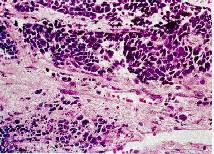
What is this?
|
|
|
What is a potential complication of eosinophilic pneumonia?
|
Churg-Strauss syndrome (eosinophilic vasculitis), which creates large areas of necrosis in any area of body.
|
|
|
Laryngeal polyp. Myxoid/gray appearance with fibrous stroma covered by squamous epithelium, some vascular proliferation in between.
|
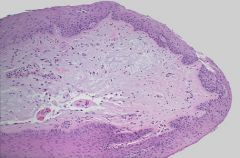
What benign neoplasm is this?
|
|
|
How does emphysema lead to airway collapse?
|
Destruction of alveolar septae --> loss of elastic recoil --> collapse during expiration
|
|
|
PCP
Foamy exudate. Cyst does not stain with normal staining methods. |
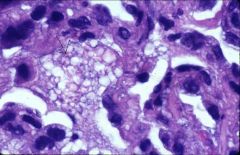
Identify process and organism
|
|
|
Actions of LTB4
Actions of LTC4, LTD4, LTE4 |
LTB4: chemoattractant
the rest: smooth muscle contraction, mucus secretion |
|
|
Nonspecific Interstitial Pneumonia
varying amounts of inflammation (lymphocytes and plasma cells) and fibrosis in alveolar walls, but no specific findings of other ILDs. Temporary uniform appearance No fibroblast foci |
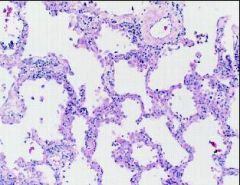
What disease?
|
|
|
Large cell carcinoma - big, pleomorphic, undifferentiated
|
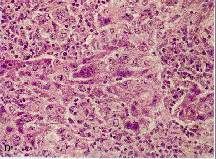
What is this?
|
|
|
Eosinophilic.
|
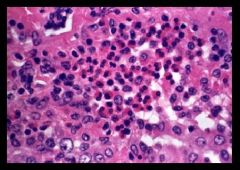
What type of pneumonia is this?
|
|
|
Laryngeal squamous papilloma.
Exophytic fronds of squamous epithelium with fibrovascular cores. HPV 6 and 11 |
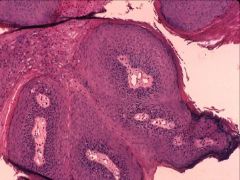
What is this? Imagine that it's growing in exophytic fronds.
What is it related to in children? |
|
|
PCP cysts (w/silver stain)
Note cup shape of cysts |
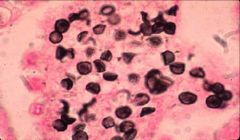
Identify organism
|
|
|
Zafirlukast, Montelukast:
Mechanism of action |
Leukotriene receptor antagonist
|
|
|
Zileuton:
Mechanism of action |
Blocks action of 5-lipoxygenase (which generates leukotrienes from arachidonic acid
|
|
|
Nonspecific Interstitial Pneumonia
|

What disease?
|
|
|
What is treatment for eosinophilic pneumonia?
|
Steroids (not an infection)
|
|
|
Which tumor is most associated with smoking?
|
Squamous cell carcinoma
|
|
|
Branchial cyst
Squamous or columnar lining with mural lymphoid infiltrate. Florid lymphocytic proliferation in underlying stroma. |
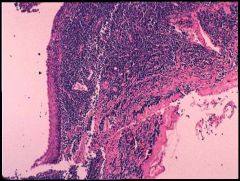
What the hell is this?
|
|
|
Blue: PCP (foamy, extracellular)
Black: CMV (owl's eye) |
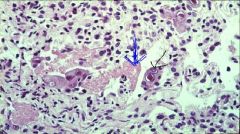
Identify organisms at blue and black arrows
|
|
|
Leukotriene modifiers:
Side effects |
Hepatotoxicity
Churg-Strauss-like syndrome |
|
|
Nonspecific Interstitial Pneumonia:
Clinical presentation (age, onset, symptoms, mortality, associations) |
mean age 50
Insidious onset dyspnea, cough 10-20% mortality Some have CVD (Collagen Vascular Disease), lung-toxic drugs or recent lung injury (e.g. pneumonia) |
|
|
Interstitial (an atypical pneumonia, caused mostly by Mycoplasma pneumoniae)
|
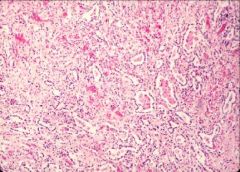
What type of pneumonia is this?
|
|
|
Squamous cell carcinoma (pink cytoplasm with distinct cell borders and intercellular bridges)
|

What is this?
|
|
|
Paraganglioma.
nests of bluish cells with vesicular looking nuclei. bland, growing in nested pattern with fibrous stroma between them. Called Zell-Ballen pattern Don't often see mitotic figures or necrosis |
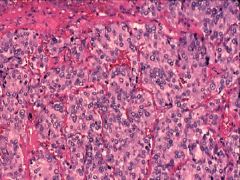
What neoplasm is this?
|
|
|
Cryptococcosis
(Pathological findings) |
Interstitial pneumonia -- parenchymal granulomas, including cavitary lesions
Immunocompromised: interstitial or alveolar involvement w/o inflammation Mucin capsule protects from immune system Can cause meningitis in immunocompromised host |
|
|
Leukotriene modifiers:
Indications |
Controller/preventer
May be used as 1st line for mild asthma, but usually an add-on with CS. May not be active in all pts |
|
|
Bronchiolitis Obliterans Organizing Pneumonia (BOOP):
Pathology |
granulation tissue plugs within the lumens of small airways. extends into alveolar ducts and alveoli.
(1) proliferation of connective tissue that forms intramural polyps (proliferative bronchiolitis obliterans); (2) fibrinous exudates; (3) alveolar accumulation of foamy macrophages; (4) inflamed alveolar walls; (5) evenly spaced, rounded balls of myxomatous connective tissue. |
|
|
What type of pneumonia is especially associated with bone marrow transplants?
|
Adenovirus pneumonia.
|
|
|
Squamous cell carcinoma
at the upper left is a squamous eddy with a keratin pearl. At the right, the tumor is less differentiated and several dark mitotic figures are seen. |
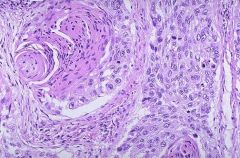
What is this?
|
|
|
BOOM! it's not a neoplasm.
This is normal salivary gland, with serous glands, ducts, and adipose tissue. |

What neoplasm is this?
|
|
|
Cryptococcus neoformans
4-7 uM oval budding yeast Capsule contains mucin Unencapsulated forms are more often found in HIV (less pathogenic) |

Identify organism
|
|
|
Short β-agonists:
2 examples |
Albuterol sulfate
Pirbuterol |
|
|
Bronchioltis Obliterans Organizing Pneumonia
(intraluminal buds of granulation tissue (bronchiolitis obliterans), involving distal airways more than alveoli) |
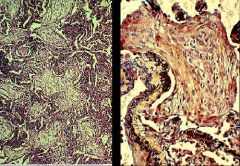
What disease?
|
|
|
What is the pathology of adenovirus pneumonia?
|
ulceration of bronchi and bronchioli with shedding of the cilia from respiratory epithelium (ciliocytophthoria). May lead to interstitial pneumonia.
|
|
|
Sialadenitis.
Inflammatory cells have taken over gland, destroyed many ducts. |
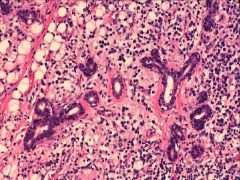
What is this?
|
|
|
Bronchioalveolar carcinoma.
Composed of columnar cells that proliferate along the framework of alveolar septae. The cells are well-differentiated. |
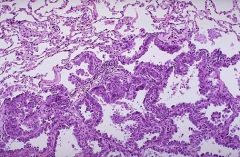
What's this?
|
|
|
Cryptococcus neoformans
(long neck budding) Use this if it's unencapsulated |
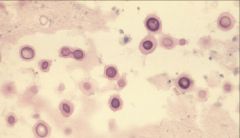
Name organism
|
|
|
Small cell carcinoma
Arising centrally in this lung and spreading extensively is a small cell anaplastic (oat cell) carcinoma. The cut surface of this tumor has a soft, lobulated, white to tan appearance. The tumor seen here has caused obstruction of the main bronchus to left lung so that the distal lung is collapsed. |
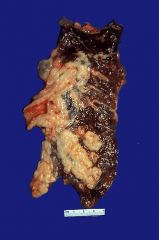
what is this?
|
|
|
BOOP:
Clinical features (Onset, symptoms, associations, PFTs, treatment) |
Subacute (faster onset - weeks)
Dyspnea, cough, weight loss Heralded by flu-like illness, looks like community-acquired pneumonia PFTs show restriction Steroids |
|
|
Short-acting β agonists:
Mechanism of action |
Relaxation of smooth muscles with β2 receptors through activation of adenylate cyclase and increased cAMP levels
|
|
|
Adenovirus.
Look at the smudge cell (arrow) in alveolar space. Also, hyaline membrane and DAD. |

What type of pneumonia is this?
|
|
|
Benign Lymphoepithelial Lesion - non-neoplastic enlargement of glands. Abnormal proliferation of lymphocytes in stroma and epithelium.
May be associated with Sjogren's syndrome |
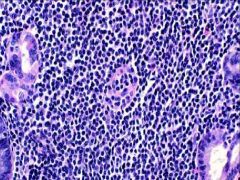
What is this? (it's in a salivary gland)
Association? |
|
|
Cryptococcus neoformans
|
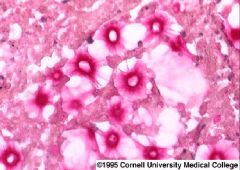
Name the organism (mucin stain)
|
|
|
Sarcoidosis
(granuloma of CD4+ T cells, epithelioid cells, macrophages, giant cells, fibroblasts, mast cells, may get fibrotic deposition if granuloma does not resolve) |

What disease?
|
|
|
β-agonist side effects
|
Tremor, palpitations, hyperglycemia, hypokalemia.
May develop tolerance |
|
|
What are the clinical characteristics of DAD/ARDS?
|
Rapid onset of severe resp insufficiency
Arterial hypoxemia Refractory response to O2 (gets worse) |
|
|
Small cell carcinoma
small dark blue cells with minimal cytoplasm are packed together in sheets. |
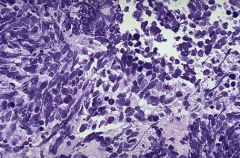
What's this?
|
|
|
Name the benign salivary gland neoplasms.
|
i. Pleomorphic adenoma/benign mixed tumors (50%)
ii. Warthrin's tumor (5-10%) iii. Oncocytoma (1%) iv. Ductal papilloma (rare) v. Monomorphic adenoma (5-10%) a. Basal cell adenoma b. Canalicular adenoma |
|
|
Aspergillosis
(Clinical presentation) |
Debilitated pts with neutropenia (not relevant in AIDS because mostly controlled by neutrophils)\
1) Allergic bronchopulmonary aspergillosis (ABPA) 2) Aspergilloma (fungus ball) 3) Invasive aspergillosis |
|
|
Sarcoidosis:
Clinical features (age, associations, treatment) |
Earlier (10-40)
Multisystem disease, may be associated with Lofgren's syndrome: erythema nodosum, often on legs, caused by panniculitis, an inflammation of subcutaneous adipose tissue), hilar adenopathy, migratory polyarthralgias, fever May spontaneously resolve, esp if symptoms were acute (Lorfgren's). Corticosteroids may give short term improvement, but long term effects are unknown. |
|
|
What is the pathogenesis of DAD/ARDS?
|
Initial injury to alveolar capillary endothelium and epithelium --> leaky capillaries and intraalveolar edema, fibrosis and reorganization of parenchyma
|
|
|
Short-acting β-agonists:
Indications |
All patients with bronchospasm, on PRN basis for fast relief. If needed more than twice weekly --> add anti-inflammatory agent
|
|
|
Is bronchial carcinoid associated with smoking?
|
No.
|
|
|
Name the malignant neoplasms of salivary glands.
|
i. Mucoepidermoid cancer (15%)
ii. Adenocarcinoma/NOS (10%) iii. Acinic cell cancer iv. Adenoid cystic cancer v. Malignant mixed tumor vi. Squamous cell vii. Other |
|
|
Allergic bronchopulmonary aspergillosis
(clinical presentation) |
In certain asthmatic pts - unusual immunologic rxn to Asp.
Transient pulmonary infiltrates on CXR Eosinophilia Elevated IgE Thickened bronchial walls w/mucus plugs on CXR Proximal bronchiectasis w/plugs Increased goblet cells, thickening of basment membrane No invasion of bronchial wall TREATMENT: steroids to get rid of inflammation |
|
|
Diffuse Alveolar Damage (DAD).
Lots of edema, disorganized. Cells where alveoli should be. Thick walls, cells are separated. |
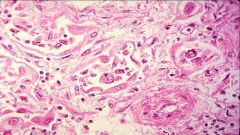
What disease process is this?
|
|
|
Chronic eosinophilic pneumonia (left)
CHF (right) negatives of each other |
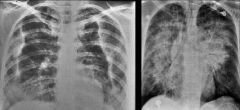
Name the two diseases
|
|
|
Long-acting β-agonists:
indications |
Maintenance (preventative) therapy
NOT for acute exacerbation NOT as anti-inflammatory not to be used w/o anti-inflammatory agent |
|
|
Bronchial carcinoid
note nests and chords of cells |
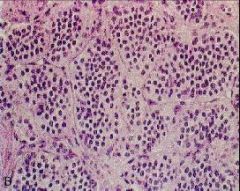
?
|
|
|
BOOYAH. Not a neoplasm.
Normal salivary gland tissue. |
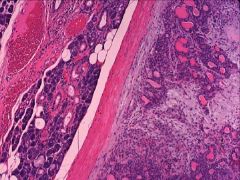
What neoplasm is this?
|
|
|
Aspergilloma
(fungus ball) |
May grow in preexisting cavities
No tissue invasion Usually asymptomatic, but may result in massive hemoptysis --> emergency |
|
|
Aspergillus spp
|
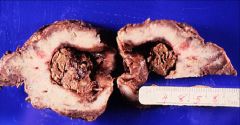
Name organism
|
|
|
DAD, later stage.
Hyaline membrane |

What disease process?
|
|
|
Hypersensitivity pneumonia
Granulomas and/or mononuclear cells Interstitial infiltrates, fibrosis in chronic |
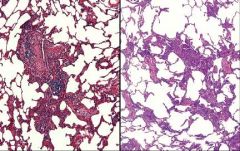
Disease?
|
|
|
Theophylline:
Mechanism of action |
Unknown, but may increase cAMP by decreasing action of phosphodiesterase and/or inhibit adenosine actions.
|
|
|
What is the most common benign lesion in the lungs?
|
Hamartoma (mature cartilage)
Looks like a "coin lesion" on X-ray |
|
|
Pleomorphic adenoma/benign mixed tumor
You can see all types of differentiation here |

What neoplasm of the salivary glands is this?
|
|
|
Invasive aspergillosis
(Pathologic features) |
Multiple patchy densities with target lesions (necrotic center w/ hemorrhagic periphery)
Tissue destruction w/vascular invasion with thrombosis Only aspergillosis that invades -- wedge shaped lesion caused by fungus invading vessel walls |
|
|
Main pathologic finding in BOOP.
|
Intraluminal organization characterized by airspace of bronchiolar plugs of fibroblasts and chronic inflammation. Organizing pneumonia --> fibrosis in alveolar space.
|
|
|
Hypersensitivity pneumonitis
granuloma, monocytes, fibrosis (looks like UIP) |
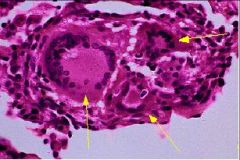
disease?
|
|
|
Theophylline:
Delivery |
Oral: slow-release, metabolized in liver that are rapidly excreted.
Lots of variation in response. May be altered by CHF, cigarettes, other meds (cimetidine, erythromycin, CCBs). Monitor levels. Also available IV |
|
|
Hamartoma. Mature cartilage, well-circumscribed.
Contains admixture of fibrous tissue, fat, blood vessels. Occasionally contains cysts lined w/respiratory epithelium |

?
|
|
|
Warthrin's tumor
Oncotic epithelium (very eosinophilic with abundant cytoplasm) lining cystic spaces. Abundant lymphocyte proliferation surrounding. |
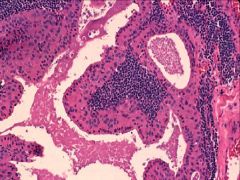
What neoplasm is this?
|
|
|
Aspergillus (invasive)
(Branched hyphae shown w/silver stain) Invading blood vessel and pulmonary parenchyma |
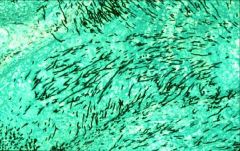
Identify organism
|
|
|
BOOP.
Fibrous plug within bronchus and alveolar spaces. |

What's this?
|
|
|
What process is ground-glass opacity indicative of?
|
Acute inflammation rather than fibrosis
|
|
|
Theophylline:
Side effects |
GI, insomnia, headache, seizures, cardiac arrhythmias
|
|
|
Is a solitary fibrous (aka localized submesothelial fibroma or pleural fibroma) accompanied by pleural effusion?
|
No.
|
|
|
What is the origin of Warthrin's tumor?
|
lymphoid cells in salivary gland.
|
|
|
Aspergillus (invasive)
Septate, branched hyphae |
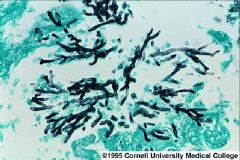
Identify organism
|
|
|
Mucoepidermoid carcinoma
Mixture of squamous cells, mucin (goblet) cells, and transitional cell forms |
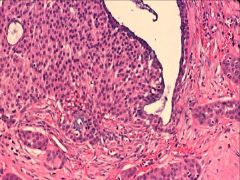
What neoplasm is this?
|
|
|
What is the treatment for BOOP?
|
Corticosteroids.
|
|
|
Mesothelioma from asbestosis. Also see plaques on left side.
|
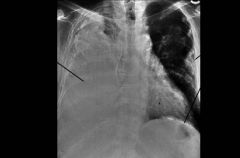
Disease?
|
|
|
Theophylline:
Indications |
Controller/preventer
Maybe in pts who still have symptoms despite other treatments. Some use in COPD. |
|
|
Sarcoidosis
(Clincal presentation) |
Multisystem granulomatous disease
Interstitial pneumonia, enlarged hilar lymphadenopathy. Mild dyspnea and cough, but may be asymptomatic CXR: bilateral interstitial opacities with or without hilar LN enlargement |
|
|
Anticholinergic agents:
Mechanism of action |
Muscarinic (M3) receptors in lung respond to ACh and lead to contraction of SMCs.
Engagement of M2 --> inhibits release of ACh Release is increased in asthma Anti-ch agents block action of M receptors nonselectively Blocking M3 --> block SMC contraction Blocking M2 --> increase ACh release and counter relaxation |
|
|
What are the diagnostic criteria for ARDS?
|
acute illness leading to hypoxemic respiratory failure, with diffuse pulmonary infiltrates that are not due to CHF.
|
|
|
What is the physiology of ARDS?
Initial damage and consequence? What happens to membranes? Alveoli? Ultimate consequence |
Diffuse alveolar damage --> leaky capillaries--> Fibrosis
fibrin deposition--> hyaline membranes and surfactant dysfunction Thrombi form --> flooding and collapse of alveoli Hypoxemia and increased dead space Respiratory failure, need for mechanical ventilation |
|
|
Sarcoidosis
(course and treatment) |
2/3 resolve spontaneously
Others may get pulmonary insufficiency, CNS, or CV involvement Tx: corticosteroids |
|
|
Anticholinergics:
example |
Ipratropium bromide
|
|
|
ARDS
L: acute exudative phase (hyaline membranes lining alveolar space) R: proliferative phase (later) - fibroblast proliferation and collagen deposition |
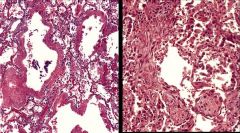
name processes and disease
|
|
|
Sarcoidosis
(Well-formed, non-necrotizing granuloma along lymphatic route) |
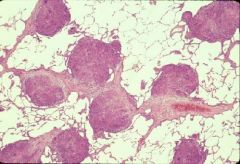
Identify process
|
|
|
Epinephrine:
Indications |
Relaxant effect on bronchial smooth muscle via stimulation of beta2-receptors. Beta2-stimulation also prevents mast cell secretion of histamine and other autocoids, thus antagonizing its effect on end organs and reversing bronchoconstriction and edema. Furthermore, alpha-stimulation may decrease secretions from the bronchial mucosa, attenuating the development of edema. There is some evidence that epinephrine's alpha properties make it more effective than pure beta-agonists for the treatment of some pulmonary conditions such as bronchiolitis in children.
|
|
|
Wegener's Granulomatosis
(Pathological findings) |
Systemic granulomatous inflammatory process with accompanying vasculitis, which predominantly affects the upper and lower respiratory tract and kidney.
1) Vasculitis 2) Necrotic granuloma 3) Inflammation (around BVs) |
|
|
Restrictive. Stiff lung. Smaller flow rates than normal, bowed out at top (increased recoil). Flow:volume ratio shows that it is very efficient.
|
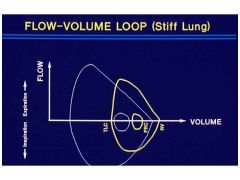
What type of disease is this?
|
|
|
Anticholinergics:
Indications |
Bronchodilator with slow onset of action (45 min).
Not a first line drug in asthma - more effective in COPD (first line) Acute exacerbation of asthma |
|
|
Wegener's granulomatosis
(treatment) |
Steroid
|
|
|
Name 5 corticosteroids:
|
Low potency: Beclomethasone, triamcinolone, flunisolide
High potency: Budesonide, fluticasone |
|
|
Long acting beta-agonist: names
|
Salmeterol
Formoterol |
|
|
Wegener's granulomatosis
Necrotizing granulomatous inflammation centered around blood vessels (veins and arteries) with an inflammatory background. |
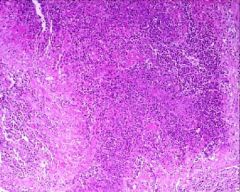
Identify what's going on
|
|
|
Extrinsic allergic alveolitis
(What is it?) |
Hypersensitivity pneumonitis caused by variety of agents (birds, etc)
|
|
|
Extrinsic allergic alveolitis
Ill-definied interstitial granulomas with lots of giant cells NO EOSINOPHILIA Granuloma is in alveolar septae |
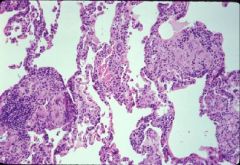
What's going on here?
|
|
|
Extrinsic allergic alveolitis
(clinical) |
Cough, fever, dyspnea, pulmonary infilitrates
|

